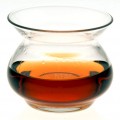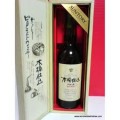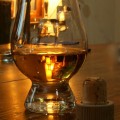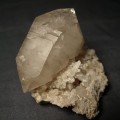Liked by:
Discussions
Which glass?
4 142
Replies: page 3/5
Discussion search
@nilsguster maybe we have one full year to write a review and create a blog! :) and the dead line is feb 2 as in 2014???
11 years ago 1Who liked this?
@CanadianNinja I know it is not identical in shape, and I know the glass you are speaking of, so when you compare I will really be interested in your findings. the large flare makes a huge difference in aromas which you will not get from the canadian glass. It will interesting to find out.
11 years ago 0
@NilsG Nils, all tongue in cheek here. your original reading of the NEAT challenge was incorrectl We want you to send us a copy of any blog that you had POSTED as of Feb. 2nd. You can still send it if Christine has not already filled the empty slots from this morning. This was to prevent late comers who had not discussed the glass at all from jumping on at the last moment to get free glasses, when we are trying to satisfy those of you who were first curious. Since we are still gathering names this week for the chanllenge, We will be sending out the 8 sets of glasses this weekend with an instruction sheet on how to use.
11 years ago 0
@BlissInABarrel Please go back and read carefully. I wanted to make sure you had been talking about the glass prior to us creating the challenge. I have no deadline for the blog, but I would appreciate getting your comments as soon as feasably possible. This is not a catch 22. Glasses will be mailed out this weekend.
11 years ago 0
@tjb Please read the glass comparison on the website, and you will see that we gave both the pluses and minuses for all glasses, including noting our own drawbacks, We believe it is an objective evaluation of all glasses. NEAT was designed for a different purpose. If you love the smell of the alcohol, Glencairn or a tulip/copita is probably right for you. We believe you get more from the whisky when the alcohol is nudged out of the way of the nose. It is still there in fine fashion in the mouth, and creeps into the olfactory lobe area AFTER you have had a chance to smell the spirit without it. In our focus groups we have found that 85% of nosers like the aromas better without the ethanol, but there are still 15% who feel the alcohol smell right at the beginning is necessary. That is personal preference. Some want a Bentley, some want a Porsche, both fine automobiles that do different things.
11 years ago 0
@Arsilicat Ah, I get it now, sorry I'm a little slow, and I will have to fall back on the poor excuse that English is not my first language.
Unfortunately I'm late to notice the last comments, for some reason I don't get email notifications for this discussion thread even though I've posted on it. I have emailed to Christine anyway. (I also wanna add that it was me who tipped off @Ivallenari about this thread, and I believe he in turn told you. If that adds any weight to my case of trying to get hold of a glass. Check out the end if this thread connosr.com/wall/discussion/…)
11 years ago 0
@Arsilicat uuuh..yeah, I'm using Nils' remark that English is not my first language, too! ^_^ I emailed your coworker! I hope I made it for the NEAT Challenge! :D Thanks again, everyone, for your helpful input!
11 years ago 1Who liked this?
@Arsilicat, perhaps I should have chosen my words a little better, you're right the glass I'm using is not 'identical' in terms of exact measurements. I was simply trying to express that it's very similar to the NEAT's shape. I welcome the opportunity do a head-to-head test with an actual NEAT glass. I also welcome the opportunity to compare a NEAT to a tulip shaped glass.
11 years ago 0
@CanadianNinja I have to tell you that in our prototype programs, we went through over fifty different actual configurations to develop the glass. Some are tall, some even shorter than the one we have but impractical to hold, some much wider and larger, and even a dram size, which we will be coming out with later as a blenders tool. Focus groups and panel evaluations determined our final design. One thing about removing the alcohol, the shapes really intensify the other aromas, and slight shape variations are noticeable without it. That is probably why I am so sensitive to the actual dimensions of our glass. Forrest Cokely, a consultant and notable rum judge designed a glass which is sized just right for the alcohol smell lover. You can purchase it at Hi times in California, and it is similar to the Canadian glass, but its slightly smaller dimensions really collect the aromas better than tulips, chimneys, copitas, etc, since its dimensions actually work better to promote evaporation. The Canadian glass is sized for those who like to plop a cube in. It has a place in the mix as well, since so many different whisky lovers love their whisky diffeently.
11 years ago 0
@NVGeo Thanks for your reply on the vapor pressure. I went back into the NEAT science page, and discovered my error on vapor pressure, thanks to your comments. Huge mistake in the way it was written, and I have corrected that. I am looking at it a little more closely to ensure I avoid any other mistakes made by oversimplification. Appreciate your input immensely.
11 years ago 0
@Arsilicat I would like to say thanks for contributing to this discussion. I am impressed that you have taken the time, shown the patience and made the kind offer of the challenge. I will certainly await the forum results with interest and may well be tempted to purchase one in the future if I decide to change drinking vessels. I had never heard of NEAT before so i am pleased you have added your input. This this kind of interaction that shows what a progressive company you are and I wish you every success in the future.
11 years ago 0
@Arsilicat Thanks for your kind words. I'm glad to have contributed to the conversation. I look forward to giving your glass a try alongside a few others I have around here. Any good reason to get out the scotch is a thing to be grateful for!
I took a look at your edits and it looks better. Although I'm not so much interested in vetting your website as I am in the performance of the glass I am still glad to see that you are willing to make the science better in your write up. However, until I have had a chance to try your glass I will refrain from weighing in on the science.
11 years ago 0
Here is a very interesting article that gets into the adding water issue quite a bit. I posted this to the 'Water in your whisky' discussion also, but I am adding it here because in the same section I mention below it also talks about how aromas are affected by adding water, and it has some relevance to this discussion.
rsc.org/chemistryworld/Issues/…
It is long, but there are some surprising facts toward the end in the section "How to drink whiskey." You could easily jump down to that if you don't want to read the whole article.
11 years ago 0
@CanuckShinobi @NeoGeo it's a good read. I think knowing this stuff actually helps one enjoying a dram even more.
11 years ago 0
@NVGeo This is a great article, and a veritable bible of the scotch making process. That being said, many things happen when the engineer or chemist is not the wordsmith in the article, and there are still many statements made in spirits communities that do not ring true scientifically. Therefore, I would like to weigh in on what we at the NEAT glass have learned about adding water to scotch.
Nothing is just simple black and white (no pun intended on the famous scotch maker).
If you go to our website pages, you will find that we do not recommend adding water to your scotch WHEN USING THE NEAT GLASS. It is a relative issue – relative to what kind of glassware you are using, and relative to your personal preference. If you use convergent rim glassware, it could be a good idea to add water if you don’t like cereal tastes and phenols (smoke). This is straight out of the article, and we also know it to be true. Also, add water if your sensitive mouth and tongue can’t stand 40 ABV. As to personal preference, we say it’s YOUR BUSINESS, but we think it is always better to know WHY you do it, and we are not so sure that science is the reason you do.
In our beginnings, we were adamant about not adding water to your whiskey, knowing full well that there is a narrow spectrum of compounds that would respond to addition of water. Our research showed us that reducing evaporation could be a good thing if you were using convergent rim glassware, because alcohol evaporation is also reduced, so we backed off and recommend NEVER add water to whiskey in the NEAT glass, which does not need it because the alcohol dissipates due to the glass shape.
What the article does not mention, is that water addition reduces ethanol evaporation. That is the precise reason most drinkers (to whom the thoughts of reducing the evaporation of water soluble compounds seldom occurs), add water. They want to give their nose a break from strong ethanol, and adding water will accomplish just that. We know for sure it raises the surface tension and slows evaporation, particularly of volatile compounds.
What is happening in the glass is both chemistry and physics. Chemists should not ignore physics, and vice-versa. Water soluble compounds will become absorbed by the water, and perhaps a few more volatile compounds will evaporate, IF they can break the surface tension (most will not). Definitely swirl if you insist on adding water.
Although Paul Hughes is the Director ICBD, like quite a few others he is not the scientist who wrote the lab report, and makes the forgivable, common error of confusing taste and flavor. Quoting from the article, and relating to adding ice or cold water, he states “…will reduce the volatility of many flavor compounds – it keeps the flavor in the liquid, so you may not get the aromas, but you’ll still get the taste.” Right about the volatility of some compounds, but flavor is the combination of taste and aroma. We only taste 6 different things, sweet, sour, salty, bitter, umame, and kokumi (excluding mouth feel) and we smell and distinguish well over a thousand. You just can’t taste an aroma, so taste is one of six things, or it ain’t a taste.
Adding water can’t keep the flavor in the liquid, and it only dilutes the aroma portion you will eventually smell from the mouth sample. As long as your tongue can taste and your nose can smell, flavor is what comes out of the liquid as a brain-inseparable perception. Again, forgivable, but when you put it in your mouth and warm it up you get aromas of whatever evaporated from the mouth sample up into the rear of the olfactory cavity. Adding water to the mouth sample dilutes, and raises surface tension in a sample that will be further diluted by saliva, which again raises the surface tension and slows evaporation.
There are three very real issues here as we see them to re-educate spirits lovers in the process of enjoying one’s favorite spirits to the max.
(1) Why not take the alcohol off the nose to protect it, so your working nose gets to go to work right away to discern aromas, and goes to work a lot longer without numbing. You get a second crack at the alcohol and the other aromas which are detected as they waft up to the olfactory from the saliva-diluted mouth sample, which will do what adding water does, but in the mouth.
(2) Why use a convergent rim glass which collects all aromas right at the rim including the nose-numbing ethanol, which has no physical geometry (as does the NEAT rim) to locate your nose in a better position to smell, and no space above the rim for alcohol to dissipate under your nose before you smell?
(3) Little is said about the time lapse after the first swallow, when you inhale a short breath of fresh air into the mouth, picking up the aromas left on the tongue and mouth sides which eddy current their way up the back passage to the olfactory. Don’t turn off your brain before you take in that time lapse, your third crack at the flavor of the spirit.
Once you establish the new baseline of enjoying your spirit without the up-front ethanol, you will pick up many more subtle differences and flavors between which you could not possibly have distinguished with a snoot full of numbing ethanol or from an overly diluted mouth sample with low evaporative characteristics.
As I said before about chemistry and physics ignoring each other, what is going on in the glass when adding the water is one thing, but what is happening in the body is another. The scientist cannot ignore the biologist, and vice-versa. The whole tasting process is chemical, physical, and physiological.
If you learn to perceive the compounds released by addition of water as saliva in the mouth, you get to experience them anyway, just not right at first whiff on the nose while fighting ethanol.
At NEAT, we say, save the nose so it works better by dissipating the alcohol, add saliva not water, take a little breath after your initial swallow, and pay attention to what you sense before you move to the next sip. All this is to save those precious olfactory neurons. It’s just a simple reordering of priorities using a different piece of hardware with a little design forethought placed on function.
There is no need for everyone to dig in their heels here, especially before trying NEAT. It is the perspective of looking at it a little differently. Try NEAT objectively, using the method we recommend for the glass, and see if you actually improved your experience. That is all we, or anyone can ask, and no more.
11 years ago 1Who liked this?
@Arsilicat Thank you for these additional thoughts. It is obvious you have put a lot of thought into the design and the process. Good for you.
The truth will be in the testing, and I think we are all eager enough for a better experience with our whisky that we will be objective.
11 years ago 0
@NilsG, CanuckShinobi... LOVE it! I should've chosen that as my handle!!
11 years ago 0
It's not quite the same thing, and I look forward to trying the NEAT glass at some point, but I cracked out my Riedel single malt glasses, which also have a flared lip, the other day. I had used them a long time ago, and really enjoyed them (oddly, mainly with bourbon, and less so for brandy). I decided to give the Pappy 23 a shot with them because I had been very disappointed with it in the glencairn and similarly shaped glasses.
In the glencairn, I was bothered by the woody varnish, which seemed excessive to me. In the Riedel (flared lip), the bourbon showed much, much better, with the varnishy quality less present and more of a regular old, wheated bourbon. I then re-sampled the Pappy with a glencairn, and, lo!, the varnish and over-wooded quality was present.
Glassware can and does make a difference. The Glencairn style glasses are pretty standard, but that doesn't mean that everything is automatically best in that shape of glass.
11 years ago 1Who liked this?
@Arsilicat Got the glasses today. Thank you. I was surprised by their heft. They look lighter weight in the pictures. I will plan a time to give them a proper test alongside some other glasses. I have a good variety of four different glasses to compare now.
11 years ago 0
OK, Here we go.
The whisky: Glenmorangie Nectar'Or. I chose this one because I recently bought this bottle for the first time. I have only had a few sips of it previously, so the aroma of it is not familiar to me. I wanted to do the test with something I did not have preconceived notions about.
The glasses. I had the NEAT glass, the Glencairn glass, a round convergent rimmed glass that came with a recent boxed set of Glenmorangie Quinta Ruban (Google glenmornagie quinta glasses and look at the images) and a divergent rimmed crystal glass shaped like an upside down bell. All the different glasses had nearly the same capacity.
And here is a personal disclaimer. I don't think of myself as having a sensitive and highly perceptive nose. It takes me a long time to identify aromas in things, often several sittings. That is why the flavor of the whisky is so much more meaningful to me than the aroma. I like big booming flavors with complexity. I ordinarily do not spend a lot of time on the nose.
Abbreviations: divergent rims:NEAT = N, Crystal Bell = C; Convergent rims: Glencairn = GC, Glenmorangie = GM,
In summary N and C made the overall strength of the aroma weaker. C basically provided no aroma at all, to the point that I might as well have simply been breathing air. In contrast GC and GM both had strong aromas. I am not talking about alcohol yet, just the intensity of the aroma, all told.
I smelled less alcohol with N, but truth be told I smelled less of everything with N. Even though the alcohol smell was a good deal stronger with GC and GM I could still smell underlying aromas in them. I was able to identify the aroma of apple pie fairly readily in GC, and GM and weakly in N. For me, being able to put a name to something in an initial nosing is unusual, but perhaps I was especially focused this time since I had been thinking about this for a week or so.
All that being said, my wife immediately identified vanilla in N, and found it more pleasant to nose than GC and GM. She agreed that C provided virtually no aroma at all. But she doesn't drink whisky at all, she only smells it, so she can't comment on the next phase of the test - the drinking test.
C provided the best experience drinking from the glass. I liked the way the fluid smoothly rolled down toward my mouth and rested against my lip as I took in a sip. Next was GC, for similar reasons. One of the pleasant things about that is that I can pause and sniff while the spirit is against my lip and then take in my sip. GM was next but I found that the larger diameter made it feel like the spirit was going to leak around my mouth if I paused and held it against my lip. Last was N for two reasons: first, the spirit tended to pour in a small rivulet toward my mouth, leaving me without a sensation of the whisky at my lip. Perhaps that is a personal preference but it is something I like. Second, the diameter of the rim is so large that there was really no way to safely pool it at my lip without it feeling like it was going to leak by me on one side or the other.
Finishing the dram (and by now I may have become slightly less objective): C was the easiest to drink from throughout. The bell shape allows the whiskey to pour easily even at the last. This glass needed to be raised less than 90 degrees to empty it. Second is tied between GC and GM both of which needed to be raised about 115 degrees to empty the glass. Last was N which needed to be raised to a chiropractically dangerous angle of about 135 degrees in order to empty the glass, something I found profoundly unpleasant, and which was a deal breaker for me with this glass.
Overall GC, GM, C, N was my order of preference. In large part this is because I like strong aromas, a pleasant experience in the drinking itself, and spinal health. That being said, I think N could be improved by making one side nearly flat. Compromises can and should be made be made because the total whisky experience does not consist of the nose alone, and the NEAT glass may currently be too focused on one functional aspect of a good glass. An assymetrical glass just might strike the correct balance.
@arsilicat Thank you for the glasses, and for the opportunity to comment upon them. If there is a perfect glass to be made your scientific approach may well be the way to get there. A design that integrates drinkability and good aroma control may be the win-win you are seeking. Keep up the good work.
11 years ago 2Who liked this?
Oops! Nectar D'or.
Obviously I was already feeling the effects of four simultaneous drinks, all finished in 30 minutes!
11 years ago 2Who liked this?
@NVGeo I gave the glasses a few tries, too -- I purchased mine (it's always worth a shot, isn't it?) I used a Glencairn, Riedel VSOP cognac, riedel single malt, and the NEAT. My experience was similar to yours. I tried three bourbons (ranging in ABV from 45-71%), three whiskies (43-58%), three armagnacs (40-49%), and three cognacs (40-60%). I did this over six non-consecutive nights.
The NEAT glass definitely diffused the alcohol the most, but it was at the cost of getting strong and distinct aromas. The first few times that I used it, I was thrown for a loop because I was confused and had a hard time understanding the aroma profile. I grew acclimated to it with use, but it never led me to get distinct aromas. This followed suit on the palate as well. High proof spirits with robust noses (not those tightly wound and needing time to open) performed better, but still a challenge.
The Riedel Single Malt was hit or miss with most things, but the aromas were more distinct than they were from the NEAT glass. I think that the slightly less exaggerated flared lip did it some favors on the palate, too.
The Riedel VSOP on the whole performed a bit more consistently than the single malt and NEAT, though it did stifle some of the breadth of aromas (it was a narrower chimney), and there was some benefit for high proof or rougher spirits with the flared lip.
Glencairn stood as the control (also very similar to the riedel xo glass that I typically use). Aromas were the strongest and most distinct here, though there were times that it did the palate few favors (for spirits that I thought had significant flaws). The NEAT and Riedel single malt did the best at covering up flaws -- though, moreso with the NEAT, at the cost of covering up some of the qualities, too.
I wonder, based on some of the rhetoric, whether we're actually the target audience for the NEAT glass. I can see somebody who wants to get into spirits, who has a tough time acclimating to the higher alcohol contact relative to wine, trying these to smooth the transition. On the other hand, for people who are accustomed to spirits (and especially higher proof spirits), and who are paying for higher end bottles, I'm not sure that this would really help them discover or fully appreciate all the secrets of the bottle.
11 years ago 3Who liked this?
@NVGeo, @NilsG, @BlissinABarrel, @CanadianNinja, @Yaklord, @FMichael I was going to wait to post this until after more people had weighed in on their original impressions of the NEAT glass, but it is apparent that the two who have tried it have pretty much made up their minds after a few tries that they appreciate the alcohol smell on the nose. That being said, you need to be reminded that unlike Glencairn or the Riedel glasses the NEAT glass has a wider mouth and rim, there is room to put your nose a little further into the glass. We recommended that you adjust your nose position on the handout we emailed to you. The wonderful thing about the NEAT glass is that you can smell at any vertical point over the center and get what the typical chimney or copitas gives you in regards to alcohol. It is just a little further down in. One glass can give you every aspect of the spirit if you just adjust your nose position. Smelling down deeper into the glass will give you more alcohol. Try it a few times with different spirits before you write it off, and also tell us whether you would prefer a stem. We have many converts from scotch drinkers who will use no other glass, but they all said it took a little getting used to, but they wouldn’t go back. Seasoned drinkers are definitely the market we are targeting, and I am curious whether the stem would make a difference in your perception of the tactility of the glass. At least try using the glass as a supplement when you evaluate an expensive spirit. I would also comment on the statement that NEAT covers up flaws in the spirit. Actually two things are happening. Most easily noticed flaws in a spirit can be traced to where the distiller made the first cut. There are many things besides ethanol alcohol, but at the same end of the spectrum that will be readily detectable in a convergent rim glass. Some of these also leave almost as quickly as the alcohol in the NEAT glass. Stick your nose a little further in, and you will definitely find them if they are there. The other thing that is happening is that without the alcohol, your baseline is changing.
Removal of the alcohol is many times perceived as “covering up” the flaws because the burn isn’t there. NEAT gives you a shot at seeing how the heavy fatty ethyl esters in the spirit work together when they can’t hide behind the ethanol aroma. Many artisan craft distillers are now using NEAT because it gives them an early handle on QC problems and the blenders find it easy to work with to achieve the blended balances they desire.
Those of you who haven't yet evaluated, we are eager for your comments.
11 years ago 1Who liked this?
@Arsilicat, I probably won't be posting a review for a little while. Partly because I am intending to purchase some other glasses I would like compare the NEAT with, and partly because I intend to review the glass after several tastings.
I assure you though, a review will be posted! Thank you for the opportunity.
11 years ago 0
@Arsilicat I hear you. I my self have objections to how the first two reviews have been done. But I will wait untill I've tried myself before commenting, otherwise I'm just speculating. But rest assured I will base my assessment on several whiskeys and on several occasions. To be fair I will follow the instructions carefully. To avoid bias I have also contacted Glencairn and they have also explained how I should best use their glass. I will include such specifics in my reviews. For the same reasons as CanadianNinja, it will take a while.
11 years ago 0
@Arsilicat - The glasses have not yet arrived, but shipping anything to Canada can sometimes take a while longer than expected. Hoping they will arrive this week. Have recruited a fellow malt-head (and my wife, who has an excellent nose, but does not drink), to help with the evaluation.
11 years ago 0
When I interpret a nose, I like to move the glass at angles to each nostril. This helps me to judge the fragrance accurately by moving the glass at different angles. I wonder if this would be unnecessary with this glass. The opening looks too big to do that. When I drink a fine whisky, I use a glencairn or long stemmed sherry glass for this reason. I am intrigued with the "neat" glass, however.
11 years ago 1Who liked this?








Use the filters above to search this discussion.